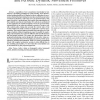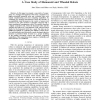542 search results - page 7 / 109 » A factorisation model of robotic tasks |
ICRA
2005
IEEE
14 years 1 months ago
2005
IEEE
Abstract— Recent research trends and technology developments are bringing us closer to the realization of autonomous multirobot systems performing increasingly complex missions. ...
TROB
2010
13 years 2 months ago
2010
Abstract--Acquisition of new sensorimotor knowledge by imitation is a promising paradigm for robot learning. To be effective, action learning should not be limited to direct replic...
IROS
2007
IEEE
14 years 1 months ago
2007
IEEE
Abstract— In this paper we present a case study of cooperation of a strongly heterogeneous robot team, composed of a highly articulated humanoid robot and a wheeled robot with la...
ICMI
2009
Springer
13 years 5 months ago
2009
Springer
Affect sensitivity is of the utmost importance for a robot companion to be able to display socially intelligent behaviour, a key requirement for sustaining long-term interactions ...
ALIFE
2010
13 years 6 months ago
2010
Embodied artificial intelligence argues that the body and brain play equally important roles in the generation of adaptive behavior. An increasingly common approach therefore is to...


